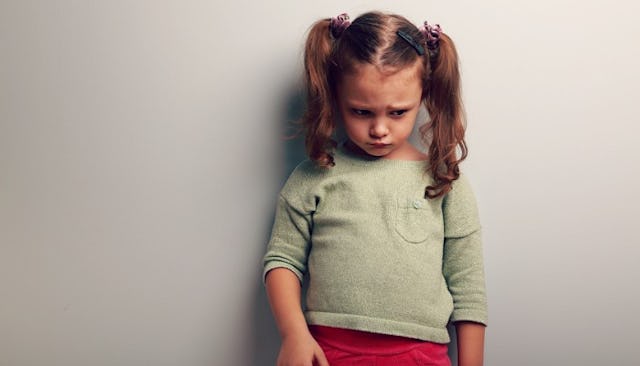I Refuse To Teach My Children That Happiness Is A Choice

Kids have feelings. Big feelings. Messy feelings. Intense, complicated, hard feelings. Anyone who’s ever spent time with a crying baby, a screaming toddler, or an angry teenager can attest to the fact that children definitely come into this world pre-programmed with a wide range of feelings.
In the time I’ve spent as an educator and a parent, I’ve come to believe that most of what society teaches children about feelings is indirect and unintentional. When it comes to my own daughters, I know I have confronted more than one temper tantrum with the message, “Stop it.” I’ve told more than one tearful little face, “Don’t be sad.”
I don’t intend to teach my kids that they shouldn’t feel things or not to have (or display) emotions, but often that’s how it comes out, because parenting little kids with big feelings is hard. Still, when children are inadvertently taught that some feelings are bad or messy or dangerous, they come to believe that they shouldn’t feel those things. Feeling anger becomes dangerous. Feeling sadness becomes failure.
This is a dangerous message because it leads children to grow up believing that they should be able to control their feelings — that it’s better or more accepted not to feel. Phrases like “happiness is a choice” carry the underlying message that you can and should be in control of your feelings. If it were actually a choice, why would anyone choose to be sad? It leads us to believe that if we are not happy, then we are not in control.
I spent many years of my life trying to control my “dangerous” feelings like anger and sadness, and it didn’t work. In fact, it only made me feel worse. It made me feel like if I wasn’t happy, it was because I was making bad decisions. I felt powerless. The more I tried to control my own feelings, the more unhappy I became. All this to avoid feeling the “bad” feelings.
It was a life-changing revelation for me when I realized that I don’t actually need to control any of my feelings because none of them are bad. It is not anger that is bad; it is what we choose to do with it that can be good or bad. It is not sadness that is bad; it is what we choose to do with it that can be good or bad.
So now, in our house, we talk about feelings, and we talk about choices — and we talk about how those are two different things. “It’s OK to be mad, but it’s not OK to be mean” is a common phrase in our house, along with many similar variations such as, “It’s OK to feel frustrated, but it’s not ok to throw a fit. What’s a better way to be frustrated?” or “It’s OK to be sad. I feel sad too. How can we be sad and still be kind?”
It’s OK to feel whatever you feel because you can feel those things and still make kind and healthy choices. There are no bad or wrong feelings. Some feelings may be more uncomfortable than others. Some feelings may be harder to feel. But they are not bad. And it is not wrong to feel them.
Additionally, I do my best to be intentional in my responses. Even when I don’t understand her sadness, I don’t tell my daughter not to be sad. I don’t believe she is choosing to be sad or scared or angry or heartbroken. Instead, I help her pay attention to the choices that led to her feelings, and the choices she can make in the midst of them.
The fact is that kids today will struggle with more depression, more suicide, more mental health challenges than any other generation before them. Being intentional in what we teach them about their emotional health is more important than ever because kids have feelings. And kids with feelings will grow up to be adults with feelings which can be intense and complicated and hard. But they are what make us human.
So rather than teach my children to demonize or deny the complicated and hard feelings, I want to help them create healthy relationships with their feelings. They don’t need to control their feelings, and their feelings don’t need to control them.
This post originally appeared on Her View From Home.
This article was originally published on